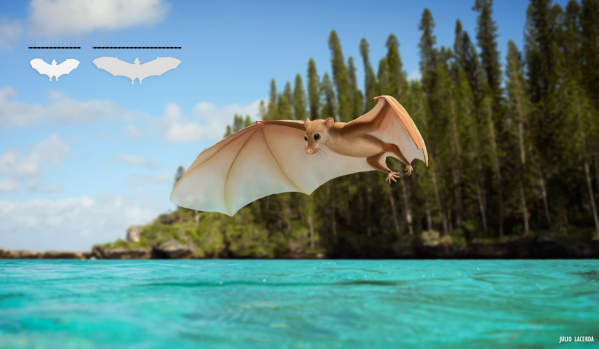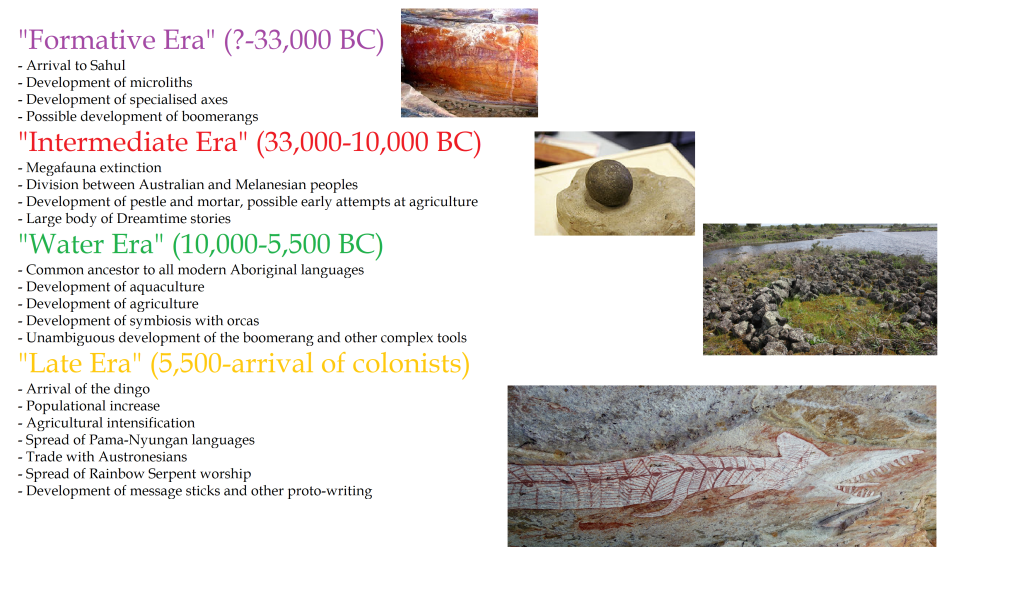There is an increasing body of evidence that, rather than primeval stasis, Aboriginal Australians underwent several technological and cultural developments for the thousands of years they have inhabitted Australia. By the time colonists arrived, Australia thrived with several complex societies that rivalled those seen in other continents, not only altering the environment to suit agricultural needs but also having developed complex law systems, long distance travelling on land and on the water, proto-writing and shoes. A combination of oral tradition supression, destruction of archaeological sites and the typical limitations of the lack of true writing make mapping Aboriginal Australian difficult, however.
I arrogantly try to rectify that here. Please add where I have missed the mark.
“Formative Era” (?-33,000 BC)
When the ancestors of Aboriginal Australians and New Guineans arrived to Sahul is unclear, the conventional wisdom being 40,000 BC but genetic and newer archaeological data may put this range of up to 80,000 BC. In this epoch the people were almost certainly hunter-gatherers and co-existed with Sahul’s megafauna such as giant marsupials and land crocodiles, of which a few notable cave paintings remain, such as depictions of Thylacoleo at Kimberley.
In this era microliths and the world’s first ground-edged axes were invented, marking the first stage in local technological inventions. The boomerang may also date to this epoch as cave paintings show, but the first unambigous boomerangs show up much later at around 10,000 BC.
Relatively few Dreamtime stories can conceivably be traced back here.
“Intermediate Era” (33,000-10,000 BC)
This epoch is marked by a variety of environmental and cultural developments. The last members of Australian’s megafauna become extinct here (some species might have disappeared much earlier but at least Zygomaturus was still around) and this is where Aboriginal Australians and Melanesians part ways, likely due to aridification in the Carpentaria Basin.
Pestle and mortar and other grinding tools are first invented here. Now that we know that Aboriginal Australians were agriculturalists and that grinding stones to make bread typically coincide with the onset of agriculture (Dark Emu, The Biggest Estate on Earth among others) this might suggest early attempts at farming in this age, which would make Aboriginal Australians some of the earliest inventors of agriculture in the world. However, low populations suggest that agriculture did not become widspread until much later.
Many Dreamtime stories date back to this era. Examples include the Gunditmajara myth of Budj Bim’s eruption, the Lake Eyre myths of Central Australian cultures and several echoes of megafauna such as the Bunyip and the Whowie. With all the changes happening with both the land and the people, this would have been a very fertile ground for imagination indeed.
“Water Era” (10,000-5,500 BC)
Much as with the rest of the world, the Holocene marks a massive set of changes in Australia. New Guinea and Tasmania are broken from Australia, ending Sahul and heralding an era of rising sea levels. Consequently, many flood myths date to this epoch, such as the formation of the Great Barrier Reef story of the Yarrabah.
The common ancestor to all known Aboriginal Australian languages is dated to the beginning of this era. If boomerangs didn’t appear earlier they definitely do here, as do several other tools like fish bone hooks. Most importantly, the oldest eel traps at Budj Bim are dated to this era, suggesting that this marks the beginning of aquaculture. Aboriginal technological developments undergo a boom, marking the beginning of hallmark that world characterise them from then on.
Yuin elders claim that the earliest cooperation between orcas and fishermen took place around this time. Combined with aquaculture, this seems to indicate a trend towards exploiting aquatic resources, no doubt prompted by the higher sea levels, but the beginnings of agricultural intensification can already be seen (Dark Emu, The Biggest Estate on Earth among others).
Late Era (5,500 BC-arrival of colonists)
The final era of pre-colonial Australians is marked by a population increase comparable to that of other continents, indicating agricultural intensification (Dark Emu, The Biggest Estate on Earth among others). This extends to Tasmanians as well, which contradicts claims of them losing even the ability of making fire. We can assume this brought about several cultural changes that seperate Aboriginal Australians from true hunter-gatherers, such as the adoption of strict gender roles over egalitarianism.
This is where the first message sticks appear, introducing proto-writing to the continent (Matthews 2014, Origins of Message Stick). This is also when the first depictions of the Rainbow Serpent appear (Aboriginal Paintings of the Wolfe Creek Crater: Track of the Rainbow Serpent), and when Pama-Nyungan languages become dominant over most of Australia. In general, this seems to be a period of several cultural and religious reforms, as to be expected from when societies grow and become more complex.
Long distance travel appears to have also been a thing by this time; through most of their history Aboriginal peoples seem to have been mostly segregated to their local lands, but by this time items belonging to South Australian cultures have been found as far north as Queensland and Budj Bim appears to have been something of a trading hub (Dark Emu, The Biggest Estate on Earth among others). Aboriginal Australians colonised the Torres Strait around this time, spreading Pama-Nyungan languages there, and I’m convinced that the Yuin and Tasmanians might have interacted.
Finally, this heralds the end of Australia’s complete isolation. Trade between northern Aboriginal peoples and Austronesians is well documented, and the dingo is thought to have arrived around 3,500 BC, in possibly several waves. Before the arrival of colonists, Australia seems to have been balls deep in international trade, with cockatoos making their way to Europe via the complex trade routes of Indonesia.
Exactly when James Cook stepped on the sands of the East Coast, several thousand years worth of history has created several nations of agriculturalists, traders, long-distance communicators, writers, storytellers, wood and stone workers and religious reformists.


